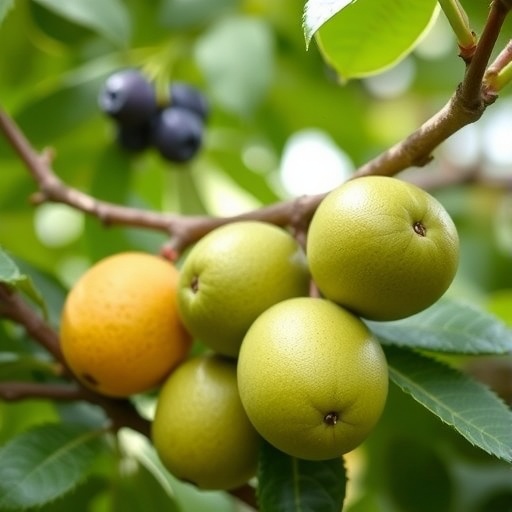In a remarkable investigation that seeks to illuminate the often-overlooked potential of indigenous biodiversity, a pioneering study illuminates the antioxidant and antidiabetic properties of ten underutilized Sri Lankan fruits. Conducted by a team of researchers led by P.G.N.H. Dharmasiri, this research opens new avenues in the domain of nutritional science and diabetes management, presenting evidence that could reshape how we perceive the dietary landscape of this tropical island.
The team meticulously selected ten Sri Lankan fruits that are not only culturally significant but also have been marginalized in terms of scientific exploration. By navigating through traditional knowledge and contemporary nutritional science, they curated a list that showcases the rich biodiversity of Sri Lanka. Many of these fruits, which include varieties that have been consumed for centuries, are laden with phytonutrients, fiber, and essential vitamins that may provide health benefits often associated with more widely consumed fruits.
The research utilized both in vitro and in vivo experimental designs to evaluate the antioxidant activity within these fruits. Antioxidants are paramount as they combat oxidative stress in the body, a condition associated with numerous chronic diseases including diabetes. The fruits examined such as the luscious wood apple and vibrant rambutan displayed promising free radical scavenging activity, which indicates their potential role in preventing oxidative damage. Advanced biochemical assays, including DPPH and FRAP tests, were employed to quantify their antioxidant prowess, producing compelling data that highlight the fruits’ capacity to enhance cellular defense mechanisms.
Moreover, the antidiabetic potential of these fruits was scrutinized using various models that simulate the physiological conditions associated with diabetes. Through a series of rigorous laboratory experiments, the researchers assessed how extracts from these fruits influence glucose uptake and insulin sensitivity. The results indicated that specific fruits like the bitter gourd fruit and the king coconut exhibit properties that could effectively lower blood sugar levels, marking a significant contribution to the dietary interventions for diabetes management.
Additionally, the study provides a comparative analysis of the nutritional profiles of the ten selected fruits against more conventional choices such as apples and bananas. It emphasizes that while the mainstream fruit options are valuable sources of vitamins, the lesser-known varieties possess unique profiles that can complement or even exceed these benefits. This rediscovery of indigenous fruits not only serves a nutritional purpose but also fosters a sense of pride and sustainability in local agricultural practices, empowering farmers to cultivate these underappreciated crops.
The implications of this research extend beyond mere dietary recommendations. By unlocking the potential of these fruits, there is hope for developing novel nutraceuticals and functional foods that harness their beneficial properties. Well-designed clinical trials are warranted to ascertain their effectiveness in real-world settings, as the promising in vitro results pave the way for further exploration. This could lead to the commercialization of health products that align with global trends towards plant-based diets and natural health supplements.
Furthermore, the environmental benefits of utilizing native fruit species present an additional argument for their promotion. Cultivating underutilized fruits can enhance biodiversity, support ecological balance, and reduce carbon footprints associated with transporting exotic fruits from distant lands. As the world grapples with climate change and seeks sustainable solutions, these fruits offer not only nutritional benefits but also environmental advantages that cannot be overlooked.
Emphasizing the role of cultural heritage in dietary choices, the study encourages communities and individuals alike to reconnect with their culinary roots. Traditional practices surrounding these fruits are rich with knowledge and methods that enhance their preparation and consumption. Reviving traditional diets can reinvigorate local economies, promote health, and reinforce cultural identity. The researchers stress that integrating these fruits back into daily diets could lead to healthier communities while celebrating Sri Lanka’s rich agricultural heritage.
Moreover, with the growing prevalence of diabetes globally, the findings of this research provide crucial insights that could influence public health policies in Sri Lanka and beyond. Promoting locally sourced, nutritionally rich fruits as part of a balanced diet could serve as an effective strategy to combat rising diabetes rates. Public health campaigns advocating for these fruits could usher in a progressive change in dietary habits and augment existing treatment protocols.
The combination of scientific research and traditional knowledge presents a compelling narrative that could resonate well with both academic and lay audiences. It underscores the importance of synergistic approaches in tackling modern health issues, urging the integration of historical wisdom into contemporary scientific practices. Engaging local communities in research endeavors can facilitate knowledge transfer and empower the populace to make informed dietary choices based on both heritage and science.
As the study sets the stage for future research, it calls for further exploration into the biochemical mechanisms behind the reported health benefits of these fruits. Understanding the synergy between various compounds present in the fruits may reveal novel approaches to health interventions and disease prevention strategies. The research advocates for collaborative efforts among scientists, nutritionists, and agricultural experts to maximize the potential of these fruits, thereby benefiting public health and promoting sustainable agriculture.
In conclusion, the study spearheaded by Dharmasiri and his colleagues offers not only a glimpse into the antioxidant and antidiabetic potential of Sri Lankan fruits but also an inspiring call to action. By embracing and promoting underutilized fruits, a pathway emerges towards enhancing health, supporting biodiversity, and fostering a more sustainable future. As the interest in plant-based diets continues to rise globally, the untapped potential of these indigenous fruits may soon deserve a seat at the table, highlighting the importance of dietary diversity for overall well-being.
Subject of Research: Antioxidant Properties and Antidiabetic Potential of Underutilized Sri Lankan Fruits
Article Title: Exploring antioxidant properties and antidiabetic potential of ten underutilized Sri Lankan fruits.
Article References:
Dharmasiri, P.G.N.H., Ranasinghe, P., Jayasooriya, R.G.P.T. et al. Exploring antioxidant properties and antidiabetic potential of ten underutilized Sri Lankan fruits.
BMC Complement Med Ther 25, 361 (2025). https://doi.org/10.1186/s12906-025-05082-8
Image Credits: AI Generated
DOI: 10.1186/s12906-025-05082-8
Keywords: Antioxidant properties, antidiabetic potential, underutilized fruits, Sri Lankan biodiversity, nutritional science, chronic disease prevention, dietary interventions.




